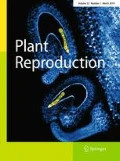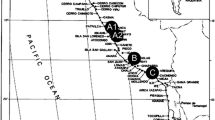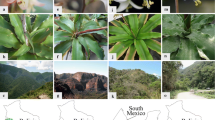Abstract
To examine breeding system characteristics of the endemic Australian prostrate shrub Kunzea pomifera, artificial hybridisations were undertaken using thirteen different genotypes of K. pomifera, to elucidate: (1) self-incompatibility, (2) intraspecific cross-compatibility in the species and (3) interspecific cross-compatibility with each of K. ambigua and K. ericoides. K. pomifera exhibited very low self-compatibility, with the barrier to self-fertilisation being prevention of pollen-tube growth in the style or ovary. Following intraspecific pollination amongst a number of different genotypes of K. pomifera, 38.4% of pollinated flowers developed fruit; arrest of compatible pollen-tubes in the style, preventing fertilisation, contributes to the low fruit set in this species. Interspecific compatibility was examined between K. pomifera (pistillate parent) and K. ambigua (staminate parent) where seed set per pollinated flower (4.47) was not significantly different from intraspecific crosses (4.66). In crosses between K. pomifera (pistillate parent) and K. ericoides as staminate plant, 0.037% of pollinated flowers produced fruit, with 0.0075 seeds per pollinated flower. Reproductive barriers between these two species were evident in the style of K. pomifera, where the growing tips of the K. ericoides pollen-tubes swelled and ceased to grow.






Similar content being viewed by others
References
Ahmed AK, Johnson KA (2000) Turner review No.3: Horticultural development of Australian native edible plants. Aust J Bot 48:417–426
Allen AM, Hiscock SJ (2008) Evolution and phylogeny of self-incompatibility systems in angiosperms. In: Franklin-Tong VE (ed) Self-incompatibility in flowering plants. Springer, Berlin, pp 73–101
Ascher PD, Peloquin SJ (1968) Pollen tube growth and incompatibility following intra- and interspecific pollinations in Lilium longiflorum. Am J Bot 55:1230–1234
Barlow BA, Forrester J (1984) Pollen tube interactions in Melaleuca. In: Knox RB, Williams EG (eds) Pollination ‘84. School of Botany, University of Melbourne, Melbourne, pp 154–159
Barrett SCH (1988) The evolution, maintenance and loss of self-incompatibility systems. In: Lovett Doust J, Lovett Doust L (eds) Plant reproductive ecology: patterns and strategies. Oxford University Press, New York, pp 98–124
Barrett SCH (1998) The evolution of mating strategies in flowering plants. Trends Plant Sci 3:335–341
Bawa KS, Webb CJ (1984) Flower, fruit and seed abortion in tropical forest trees—implications for the evolution of paternal and maternal reproductive patterns. Amer J Bot 71:736–751
Beardsell DV, Knox RB, Williams EG (1993a) Breeding system and reproductive success of Thryptomene calycina (Myrtaceae). Aust J Bot 41:333–349
Beardsell DV, O’Brien SP, Williams EG, Knox RB, Calder DM (1993b) Reproductive biology of Australian Myrtaceae. Aust J Bot 41:511–526
Bernacchi D, Tanksley SD (1997) An interspecific backcross of Lycopersicon esculentum × L. hirsutum: linkage analysis and a QTL study of sexual compatibility factors and floral traits. Genetics 147:861–877
Bernasconi G, Ashman TL, Birkhead TR, Bishop JDD, Grossniklaus U, Kubli E, Marshall DL, Schmid B, Skogsmyr I, Snook RR, Taylor D, Till-Bottraud I, Ward PI, Zeh DW, Hellriegel B (2004) Evolutionary ecology of the prezygotic stage. Science 303:971–975
Birrenkott BA, Stang EJ (1989) Pollination and pollen tube growth in relation to cranberry fruit development. J Amer Soc Hort Sci 114:733–737
Bittencourt NS, Semir J (2004) Pollination biology and breeding system of Zeyheria montana (Bignoniaceae). Plant Syst Evol 247:241–254
Boland DJ, Sedgley M (1986) Stigma and style morphology in relation to taxonomy and breeding systems in Eucalyptus and Angophora (Myrtaceae). Aust J Bot 34:569–584
Brewbaker JL (1957) Pollen cytology and incompatibility systems in plants. J Hered 48:271–277
Bumrungsri S, Sripaoraya E, Chongsiri T, Sridith K, Racey PA (2009) The pollination ecology of durian (Durio zibethinus, Bombacaceae) in southern Thailand. J Trop Ecol 25:85–92
Burrell J (1965) Ecology of Leptospermum in Otago. New Zeal J Bot 3:3–16
Callan NW, Lombard PB (1978) Pollination effects on fruit and seed development in ‘Comice’ pear. J Amer Soc Hort Sci 103:496–500
Clarke PA (1998) Early Aboriginal plant use in southern South Australia. Proc Nutri Soc S Aust 22:17–20
Cruzan MB, Barrett SCH (1996) Postpollination mechanisms influencing mating patterns and fecundity: an example from Eichhornia paniculata. Am Nat 147:576–598
Darnell R, Lyrene PM (1989) Cross-incompatibility of two related rabbiteye blueberry cultivars. Hort Sci 24:1017–1018
de Lange PJ, Norton DA (2004) The ecology and conservation of Kunzea sinclairii (Myrtaceae), a naturally rare plant of rhyolitic rock outcrops. Biol Conserv 117:49–59
de Lange PJ, Datson PM, Murray BG, Toelken HR (2005) Hybridism in the Kunzea ericoides complex (Myrtaceae): an analysis of artificial crosses. Aust Syst Bot 18:15
de Nettancourt D (1977) Incompatibility in angiosperms. Springer, Berlin
de Nettancourt D (1997) Incompatibility in angiosperms. Sex Plant Reprod 10:185–199
de Nettancourt D (2001) Incompatibility and incongruity in wild and cultivated plants. Springer, New York, p 322
Dicenta F, Ortega E, Canovas JA, Egea J (2002) Self-pollination vs. cross-pollination in almond: pollen tube growth, fruit set and fruit characteristics. Plant Breeding 121:163–167
Dong Y-H, Kvarnheden A, Yao J-L, Sutherland PW, Atkinson RG, Morris BA, Gardner RC (1998) Identification of pollination-induced genes from the ovary of apple (Malus domestica). Sex Plant Reprod 11:277–283
Drake DW (1981) Reproductive success of two Eucalyptus hybrid populations. I Generalised seed output model and comparison of fruit parameters. Aust J Bot 29:25–35
Dražeta L, Lang A, Hall AJ, Volz RK, Jameson PE (2004) Modelling the influence of seed set on fruit shape in apple. J Hort Sci Biotechnol 79:241–245
El-Agamy SZA, Sherman WB, Lyrene PM (1981) Fruit set and seed number from self- and cross-pollinated highbush (4x) and rabbiteye (6x) blueberries. J Amer Soc Hort Sci 106:443–445
Eldridge KG, Davidson J, Harwood J, Van Wyk G (1993) Eucalypt domestication and breeding. Clarendon Press, Oxford
Elliot RW, Jones DL (1993) Encyclopaedia of Australian plants: suitable for cultivation. Lothian Publishing, Melbourne
Ellis MF, Sedgley M (1992) Floral morphology and breeding system of three species of Eucalyptus, section Bisectaria (Myrtaceae). Aust J Bot 40:249–262
Endress PK (2001) The flowers in extant basal angiosperms and inferences on ancestral flowers. Int J Plant Sci 162:1111–1140
Endress PK, Igersheim A (2000) Gynoecium structure and evolution in basal angiosperms. Int J Plant Sci 161:S211–S223
Faivre AE (2002) Variation in pollen tube inhibition sites within and among three heterostylous species of Rubiaceae. Int J Plant Sci 163:783–794
Fritz NK, Hanneman RE (1989) Interspecific incompatibility due to stylar barriers in tuber-bearing and closely related non-tuber-bearing Solanums. Sex Plant Reprod 2:184–192
Gibbs PE, Bianchi MB (1999) Does late-acting self-incompatibility (LSI) show family clustering? Two more species of Bignoniaceae with LSI: Dolichandra cynanchoides and Tabebuia nodosa. Ann Bot 84:449–457
Godley EJ, Smith DH (1981) Breeding systems in New Zealand plants 5. Pseudowintera colorata (Winteraceae). NZ J Bot 19:151–156
Graham C, Hart D (1997) Prospects for the Australian native bushfood industry. Rural Industries Research and Development Corporation, Canberra
Griffin AR (1982) Pollination ecology of Eucalyptus—a framework for study. In: Knox RB, Williams EG, Gilbert JH, Bernhardt P (eds) Pollination ‘82. School of Botany, University of Melbourne, Melbourne, pp 42–56
Griffin AR, Moran GF, Fripp YJ (1987) Preferential outcrossing in Eucalyptus regnans F. Muell Aust J Bot 35:465–475
Hancock CN, Kondo K, Beecher B, McClure B (2003) The S-locus and unilateral incompatibility. Philos Trans Roy Soc B 358:1133–1140
Harris W, Porter NG, Dawson MI (1992) Observations on biosystematic relationships of Kunzea sinclairii on an intergeneric hybrid Kunzea sinclairii × Leptospermum scoparium. NZ J Bot 30:213–230
Herrero M, Hormaza JI (1996) Pistil strategies controlling pollen tube growth. Sex Plant Reprod 9:343–347
Hiscock SJ, Dickinson HG (1993) Unilateral incompatibility within the Brassicaceae: further evidence for the involvement of the self-incompatibility (S)-locus. Theor Appl Genet 86:744–753
Hiscock SJ, Kües U (1999) Cellular and molecular mechanisms of sexual incompatibility in plants and fungi. Int Rev Cytol 193:165–295
Hiscock SJ, McInnis SM (2003) The diversity of self-incompatibility systems in flowering plants. Plant Biol 5:23–32
Hogenboom NG (1973) A model for incongruity in intimate partner relationships. Euphytica 21:405–414
Hogenboom NG (1975) Incompatibility and incongruity: two different mechanisms for the non-functioning of intimate partner relationships. Proc Roy Soc London Ser B-Biol Sci 188:361–375
Hogenboom NG (1984) Incongruity: non-functioning of intercellular and intracellular partner relationships through non-matching information. In: Linskens HF, Heslop-Harrison J (eds) Cellular interactions. Springer, Berlin, pp 640–654
Hormaza JI, Herrero M (1992) Pollen selection. Theor Appl Genet 83:663–672
Horsley TN, Johnson SD (2007) Is Eucalyptus cryptically self-incompatible? Ann Bot 100:1373–1378
Kenrick J, Kaul V, Williams EG (1986) Self-incompatibility in Acacia retinodes: site of pollen-tube arrest is the nucellus. Planta 169:245–250
Kuboyama T, Chung CS, Takeda G (1994) The diversity of interspecific pollen-pistil incongruity in Nicotiana. Sex Plant Reprod 7:250–258
Leakey RRB, Page T (2006) The ‘ideotype concept’ and its application to the selection of cultivars of trees providing agroforestry tree products. For Trees Livelihoods 16:5–16
Lewis D, Crowe LK (1958) Unilateral interspecific incompatibility in flowering plants. Heredity 12:233–256
Liedl BE, McCormick S, Mutschler MA (1996) Unilateral incongruity in crosses involving Lycopersicon pennellii and L. esculentum is distinct from self-incompatibility in expression, timing and location. Sex Plant Reprod 9:299–308
Lloyd DG (1980) Sexual strategies in plants. I. An hypothesis of serial adjustment of maternal investment during one reproductive session. New Phytol 86:69–79
Lloyd DG, Webb CJ, Primack RB (1980) Sexual strategies in plants. II. Data on the temporal determination of maternal investment. New Phytol 86:81–92
Lo KH, Chen IZ, Chang TL (2007) Pollen-tube growth behaviour in ‘Chanee’ and ‘Monthong’ durians (Durio zibethinus L.) after selfing and reciprocal crossing. J Horticult Sci Biotechnol 82:824–828
Lopez GA, Potts BM, Tilyard PA (2000) F1 hybrid inviability in Eucalyptus: the case of E. ovata × E. globulus. Heredity 85:242–250
Lundqvist A (1965) The nature of the two-loci incompatibility system in grasses. IV. Interaction between the loci in relation to pseudo-compatibility in Festuca pratensis Huds. Hereditas 52:221–234
McClure BA, Cruz-Garcia F, Beecher B, Sulaman W (2000) Factors affecting inter- and intraspecific pollen rejection in Nicotiana. Ann Bot 85(Suppl. A):113–123
McCubbin A, Dickinson H (1997) Self-incompatibility. In: Shivanna KR, Sawhney VK (eds) Pollen biotechnology for crop production and improvement. Cambridge University Press, Cambridge, pp 199–217
McCubbin AG, Kao TH (2000) Molecular recognition and response in pollen and pistil interactions. Annu Rev Cell Devel Biol 16:333–364
Mulcahy DL (1979) Rise of the angiosperms: a genecological factor. Science 206:20–23
Murfett J, Strabala TJ, Zurek DM, Mou B, Beecher B, McClure BA (1996) S RNase and interspecific pollen rejection in the genus Nicotiana: multiple pollen-rejection pathways contribute to unilateral incompatibility between self-incompatible and self-compatible species. Plant Cell 8:943–958
Mutschler MA, Liedl BE (1994) Interspecific crossing barriers in Lycopersicon and their relationship to self-incompatibility. In: Williams EG, Clarke AE, Knox RB (eds) Genetic control of self-incompatibility and reproductive development in flowering plants. Kluwer, Dordrecht
O’Brien SP (1994) Pistil structure and pollen tube pathways in Leptospermum myrsinoides and L. continentale (Myrtaceae). Ann Bot 73:225–230
O’Brien SP (1996) Timetable of stigmatic receptivity and development and pollen tube growth in Chamelaucium uncinatum (Myrtaceae). Aust J Bot 44:649–659
Onus AN, Pickersgill B (2004) Unilateral incompatibility in Capsicum (Solanaceae): occurrence and taxonomic distribution. Ann Bot 94:289–295. doi:10.1093/aob/mch139
Ortega E, Dicenta F (2006) Self-fertilization in homozygous and heterozygous self-compatible almonds. Sci Hortic 109:288–292
Page T (2000) Grafting in the cultivation of Kunzea pomifera (F.Muell) Muntries. Comb Proc Intl Plant Prop Soc 50:109–114
Page T (2003) Muntries: the domestication and improvement of Kunzea pomifera. Rural Industries Research and Development Corporation, Canberra
Page T, Moore GM, Will J, Halloran GM (2006a) Onset and duration of stigma receptivity in Kunzea pomifera (Myrtaceae). Aust J Bot 54:559–563
Page T, Moore GM, Will J, Halloran GM (2006b) Pollen viability in Kunzea pomifera (Myrtaceae) as influenced by sucrose concentration and storage. Aust J Bot 54:553–558
Pandey KK (1981) Evolution of unilateral incompatibility in flowering plants: further evidence in favour if twin specificities controlling intra- and interspecific incompatibility. New Phytol 89:705–728
Potts BM (1986) Population dynamics and regeneration of a hybrid zone between Eucalyptus risdonii Hook. f. and E. amygdalina Labill. Aust J Bot 34:305–329
Pound LM, Wallwork MA, Potts BM, Sedgley M (2002) Self-incompatibility in Eucalyptus globulus ssp. globulus (Myrtaceae). Aust J Bot 50:365–372
Richards A (1997) Plant breeding systems. Chapman and Hall, London
Rieseberg LH, Carney SE (1998) Plant hybridization. New Phytol 140:599–624
Rohitha BH, Klinac DJ (1990) Relationship between seed set and fruit weight and shape of nashi (Pyrus serotina Rehder var. culta Rehder). NZ J Crop Hort Sci 18:133–136
Sage TL, Sampson FB (2003) Evidence for ovarian self-incompatibility as a cause of self-sterility in the relictual woody angiosperm, Pseudowintera axillaris (Winteraceae). Ann Bot 91:807–816. doi:10.1093/aob/mcg085
Sage TL, Bertin R, Williams EG (1994) Ovarian and other late-acting self-incompatibility. In: Williams EG, Clarke AE, Knox RB (eds) Genetic control of self incompatibility and reproductive development in flowering plants. Kluwer, Dordrecht, pp 116–140
Seavey SR, Bawa KS (1986) Late-acting self-incompatibility in angiosperms. Bot Rev 52:195–219
Sedgley M (1985) Some effects of temperature and light on floral initiation and development in Acacia pycnantha. Aust J Plant Physiol 12:109–118
Sedgley M (1994) Self-incompatibility in woody horticultural species. In: Williams EG, Clarke AE, Knox RB (eds) Genetic control of self-incompatibility and reproductive development in flowering plants. Kluwer, Dordrecht
Sedgley M, Smith RM (1989) Pistil receptivity and pollen tube growth in relation to the breeding system of Eucalyptus woodwardii (Symphyomyrtus: Myrtaceae). Ann Bot 64:21–31
Sedgley M, Hand FC, Smith RM, Griffin AR (1989) Pollen tube growth and early seed development in Eucalyptus regnans F Muell. (Myrtaceae) in relation to ovule structure and preferential outcrossing. Aust J Bot 37:397–411
Shivanna KR (1997) Barriers to hybridisation. In: Shivanna KR, Sawhney VK (eds) Pollen biotechnology for crop production and improvement. Cambridge University Press, Cambridge, pp 261–272
Takada Y, Nakanowatari T, Sato J, Hatakeyama K, Kakizaki T, Ito A, Suzuki G, Shiba H, Takayama S, Isogai A, Watanabe M (2005) Genetic analysis of novel intra-species unilateral incompatibility in Brassica rapa (syn. campestris) L. Sex Plant Reprod 17:211–217
Takayama S, Isogai A (2005) Self-Incompatibility in plants. Annu Rev Plant Biology 56:467–489. doi:10.1146/annurev.arplant.56.032604.144249
Tierney DA, Wardle GM (2005) Differential seed ecology in the shrubs Kunzea rupestris, K. capitata and associated hybrids (Myrtaceae): the function of thin-walled fruit in a fire-prone vegetation. Aust J Bot 53:9
Tierney DA, Wardle GM (2008) The relative fitness of parental and hybrid Kunzea (Myrtaceae): the interaction of reproductive traits and ecological selection. Amer J Bot 95:146–155
Tilton VR, Horner HT (1980) Stigma, style, and obturator of Ornithogalum caudatum (Liliaceae) and their function in the reproductive process. Amer J Bot 67:1113–1131
Trueman SJ, Turnbull CGN (1994) Effects of cross-pollination and flower removal on fruit set in Macadamia. Ann Bot 73:23–32
Vander Kloet SP, Lyrene PM (1987) Self-incompatibility in diploid, tetraploid and hexaploid Vaccinium corymbosum. Can J Bot 65:660–665
Whitehouse HLK (1950) Multiple allelomorph incompatibility of pollen and style in the evolution of angiosperms. Ann Bot NS 14:198–216
Wilson PG (2002) Kunzea. In: Harden GJ (ed) Flora of New South Wales. UNSW Press, Sydney, pp 174–178
Acknowledgments
T. P. was the recipient of an Australian Postgraduate Award (APA), and the project received funding support from the Rural Industries Research and Development Corporation (RIRDC) and RWS Nicholas Agricultural Science Scholarship. Neville Bonney kindly donated the ‘Ba’ accession for use in this study.
Author information
Authors and Affiliations
Corresponding author
Additional information
Communicated by Andrew Stephenson.
Rights and permissions
About this article
Cite this article
Page, T., Moore, G.M., Will, J. et al. Breeding behaviour of Kunzea pomifera (Myrtaceae): self-incompatibility, intraspecific and interspecific cross-compatibility. Sex Plant Reprod 23, 239–253 (2010). https://doi.org/10.1007/s00497-010-0133-0
Received:
Accepted:
Published:
Issue Date:
DOI: https://doi.org/10.1007/s00497-010-0133-0




